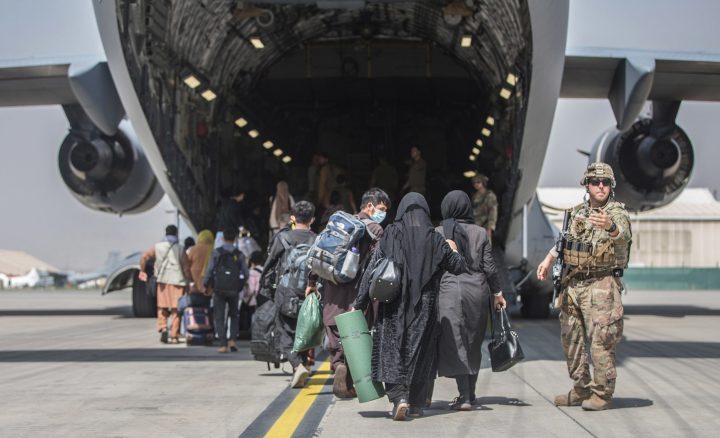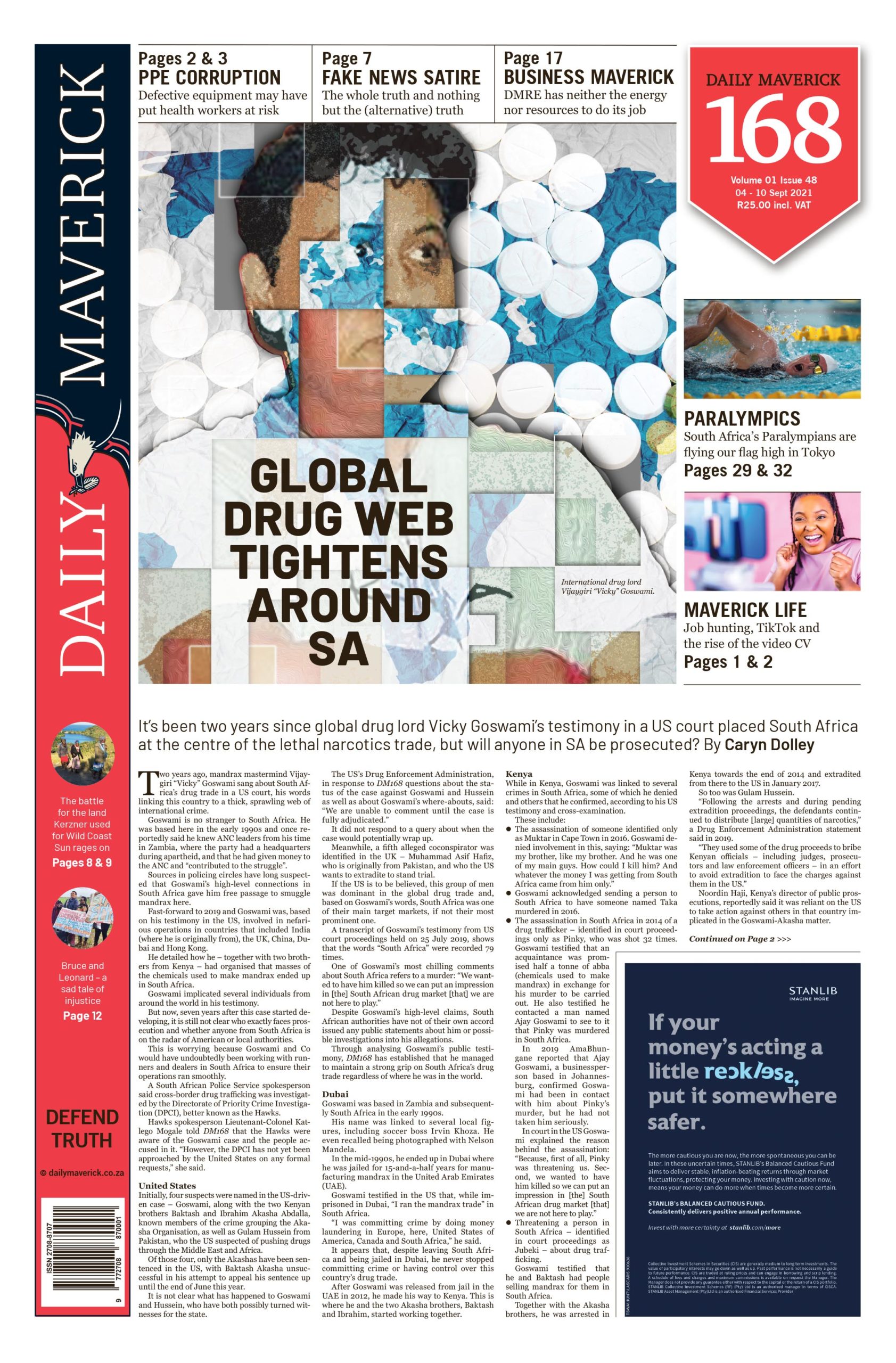DM168 GLOBAL VIEWS
It’s the end of US involvement in Afghanistan, but the beginning of strategic responses from neighbours

The US’s withdrawal from Afghanistan is finally over, but the ‘Great Game’ continues with many players.
First published in the Daily Maverick 168 weekly newspaper.
The last of those giant American C-17 transport planes have now departed Kabul for the final time with their cargoes of Afghans, Americans and crucial bits of military equipment, as the American redoubt at Kabul’s international airport closed shop. Over 17 days, 124,000 people departed via that air bridge.
Viewed as a feat of logistics, the evacuation was extraordinary. The only possible parallel is the evacuation of the British Expeditionary Force from Dunkirk at the beginning of World War 2. US diplomats previously in Kabul are now setting up a temporary embassy-in-exile in Doha, where much of their task will be dealing with Afghans still desperate to leave the country because of fears of retribution from the Taliban.
Meanwhile, most of the Afghans evacuated have been placed in temporary processing centres such as America’s Ramstein Air Base in Germany, as onward destinations are sorted out. The millions in Afghanistan, of course, are having to come to terms with what Taliban rule version 2.0 may mean. Will it be similar to what they endured the first time, or, as some Taliban leaders seem to have said, things will be different, although still in accordance with Sharia law.
The exodus from Kabul included Afghans who had worked with the US and others over the course of the war and who believed their lives were at risk with the arrival of the Taliban, Afghans who already had entry visas to the US and picked that moment to make their move, and nearly 6,000 Americans, public and private, who included all remaining military personnel and new troops sent to manage the airlift and keep it secure, the civilian maintenance contractors who had been crucial in keeping the equipment of the Afghan army and airforce working, embassy staff processing those emergency visas, and then, among the last, the American ambassador.
The safety and wellbeing of the remaining thousands of Afghans with those coalition connections inside their country, as well as a handful of Americans still in the country, may become bargaining chips in a future relationship between the US and the Taliban regime. Other yet-to-be-determined factors will be if the new Taliban government ensures Islamist/fundamentalist/terror groups cannot use Afghan territory as bases of operations in the way al-Qaeda did the last time the Taliban was in power, during the 2001 attacks on the Pentagon and World Trade Center.
Further, to the extent the Taliban again denies the rights of female Afghanis to work, study or move about freely, this will also affect how the rest of the world views and engages with this new regime. But for now, none of these questions yet have good answers, and insights for predictions of their behaviour are scant as well.
On the other side of the equation, the US has frozen $9-billion-plus in Afghan assets, making them inaccessible to the country’s new rulers, even as those funds are increasingly needed. Similarly, the International Monetary Fund has – at least for now – frozen $1-billion-plus in Special Drawing Rights funds, pending future developments.
Access to those funds (let alone new foreign economic aid) could become strong bargaining positions in nurturing a willingness by the Taliban to facilitate additional departures of people who believe they are under serious threat, or to effect strong restraints on extremist groups. Further, there will be the possibility of holding off the ill-treatment of women and girls, along with restraining other aspects of a medieval style of governance that was the hallmark of the Taliban’s first try.
Motivations for behavioural change might also include the reality that Afghanistan faces a severe and growing food availability crisis, a serious lack of resources to fund government operations and salaries (US aid had covered much of that cost previously), and the need to cope with the impoverishment of the people and to deliver a cogent response to the Covid-19 pandemic.
But here, too, the shape of decisions to deal with such questions remains murky.
Just how did America find itself embedded in two decades of struggle in a distant central Asian nation? That largely arose during the latter years of the Cold War, after a socialist regime had taken over Afghanistan and, then, to support it against rebel forces, the Soviet Union dispatched an army of some 115,000 to the country. Ultimately that force sustained around 15,000 fatalities before withdrawing in 1989.
American aid to those rebels came in the form of Stinger anti-aircraft missiles that effectively downed Russian attack helicopters, becoming a game changer, thus leading to the defeat of the leftist regime — and advancing the collapse of the Soviet Union as well because of that defeat and its many casualties.
Several years later, the Taliban eventually became the newest replacement regime. For Americans, the proximate cause of their invasion was that Afghanistan had been a sanctuary for the al-Qaeda force that carried out the 11 September 2001 attacks in the US.
In retaliation, President George W Bush authorised a military campaign against al-Qaeda that quickly eliminated it as an effective fighting force and that sent its remnants scrambling into the high mountain reaches of northwestern Pakistan. In 2002, however, the Bush administration began to embrace a more all-encompassing goal of defeating the Taliban as well, thus setting as a goal the reshaping of Afghanistan as a modern, more democratic state, as a messianic effort of “nation building”.
Over the years, American and other Western nations poured in economic aid, military assistance, and military and civilian personnel in their struggle to confront a resurgent Taliban that was gradually capturing much of the country. Americans increasingly tired of the conflict (just as they were being worn down further by a similar campaign in Iraq that had been instigated by a false belief that Saddam Hussein’s regime was on the cusp of developing nuclear weapons), and the balance in Afghanistan increasingly tilted towards the Taliban until the Obama administration carried out a major troop surge (a policy, incidentally, opposed by then vice-president Biden) to salvage the situation.
Eventually, over the years, as the military commitment was being wound down, the best guess (or hope) by the US military and intelligence community was that the Afghan government could hold on for at least half a year more, after all foreign military forces were withdrawn. To end this “forever war” and in parallel with his own visceral feeling about military commitments abroad, then president Donald Trump reached an accord in February 2020 with Taliban representatives in Doha that called for the departure of foreign forces by mid-2021, in return for a cessation of attacks on them, and a loose understanding that the Taliban would seek to establish a new, broader government for the nation.
The new American president, Joe Biden, largely adopted the Trump framework. American forces were quickly withdrawn from their main facility at Bagram Airbase, setting in motion the final withdrawal. But that decision demonstrated how poorly the Afghan military and government could maintain even partial effectiveness and Taliban forces made rapid progress in subduing most of the country, culminating in their near-bloodless entry into Kabul. The Americans and their partners set up a perimeter at Kabul’s other airport, where they were besieged by thousands of Afghans, all desperate to leave.

Taliban forces rally to celebrate the withdrawal of US forces in Kandahar, Afghanistan, on 1 September 2021. (Photo: EPA-EFE / STRINGER)
After the withdrawal, President Biden then spoke on 31 August to explain his views on the end of the conflict and a way forward.
He said: “In April, I made the decision to end this war. As part of that decision, we set the date of August 31st for American troops to withdraw. The assumption was that more than 300,000 Afghan National Security Forces that we had trained over the past two decades and equipped would be a strong adversary in their civil wars with the Taliban. That assumption – that the Afghan government would be able to hold on for a period of time beyond military drawdown – turned out not to be accurate…”
Besides the 124,000 people who departed through the airlift, Biden noted: “Now we believe that about 100 to 200 Americans remain in Afghanistan with some intention to leave. Most of those who remain are dual citizens, long-time residents who had earlier decided to stay because of their family roots in Afghanistan.
“We succeeded in what we set out to do in Afghanistan over a decade ago. Then we stayed for another decade. It was time to end this war. This is a new world. The terror threat has metastasised across the world, well beyond Afghanistan. We face threats from al-Shabaab in Somalia; al-Qaeda affiliates in Syria and the Arabian Peninsula; and Isis attempting to create a caliphate in Syria and Iraq, and establishing affiliates across Africa and Asia.
“The fundamental obligation of a president, in my opinion, is to defend and protect America – not against threats of 2001, but against the threats of 2021 and tomorrow. That is the guiding principle behind my decisions about Afghanistan…
“The world is changing. We’re engaged in a serious competition with China. We’re dealing with the challenges on multiple fronts with Russia. We’re confronted with cyberattacks and nuclear proliferation. We have to shore up America’s competitive[ness] to meet these new challenges in the competition for the 21st century. And we can do both: fight terrorism and take on new threats that are here now and will continue to be here in the future. And there’s nothing China or Russia would rather have, would want more in this competition than the United States to be bogged down [for] another decade in Afghanistan,” Biden said.
He insisted there would still be support for Afghans “through diplomacy, international influence, and humanitarian aid. We’ll continue to push for regional diplomacy and engagement to prevent violence and instability. [And] We’ll continue to speak out for basic rights of the Afghan people, especially women and girls, as we speak out for women and girls all around the globe.
“And I’ve been clear that human rights will be the centre of our foreign policy. But the way to do that is not through endless military deployments, but through diplomacy, economic tools, and rallying the rest of the world for support,” Biden said.
Not surprisingly, Republican politicians chose, almost immediately, to lambast the president, either because he acted too decisively in leaving Afghanistan (ironically, by carrying out Trump’s plan), or because he did not reinsert ground forces there, despite the collapse of the government America had been supporting. As a now-Washington-based friend who had served in Afghanistan observed: “The issue is turning into a partisan food fight. Everyone has his talking points. Republicans are throwing mud at Biden even though he executed Trump’s plan. Democrats are defending Biden even though they accused Trump of selling out the Afghans and would have impeached Trump if he had pulled out the way Biden did. Bad faith is universal.”
Still, if a reasonably stable regime takes hold, if it does not return to the oppression of the female half of its population, if it allows those who still wish to leave to do so, and if it actually prevents terror groups from using Afghanistan as bases of operations, by the 2022 US midterm election, it is possible Democrats may turn these events into a net positive — or at least not have it be viewed as Biden’s dreadful failure. This may be especially true if the economy continues to heal, and if the Covid pandemic is finally beaten down.
What still needs to be considered is how Afghanistan’s neighbours will develop their own strategies. Will China move strongly to exploit mining and other economic opportunities, bringing Afghanistan into its Belt and Road and Shanghai Cooperation Council initiatives? Will India engage more strongly in Afghanistan in a counterbalance to Chinese influence? Or will Pakistan finally sort out how to use its long-standing, shadowy relationship with the Taliban to support efforts for a less conflict-ridden Afghanistan? And will Iran believe it must forcibly protect Afghanistan’s Shia minority, and other minorities with ethnic affinities to Iran?
The biggest imponderable is if the Taliban can broker an effective peace with the remaining successors to the old Northern Alliance and Mujahideen, avoiding a new round in what seems like Afghanistan’s perpetual state of conflict and opportunities for foreign entanglements. Only time will tell. DM168
This story first appeared in our weekly Daily Maverick 168 newspaper which is available for R25 at Pick n Pay, Exclusive Books and airport bookstores. For your nearest stockist, please click here.





















 Become an Insider
Become an Insider
Comments - Please login in order to comment.